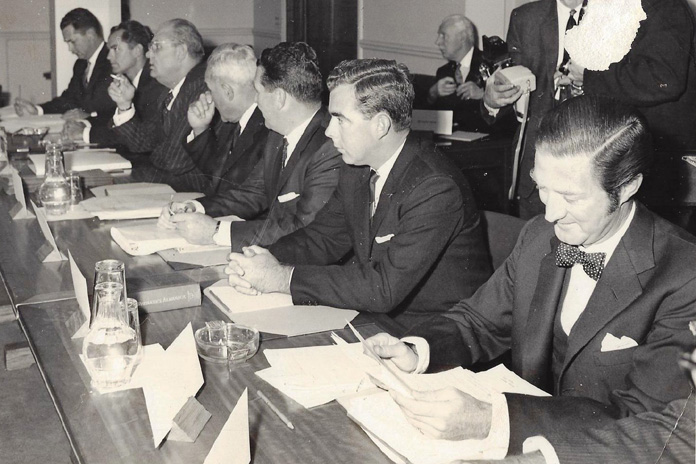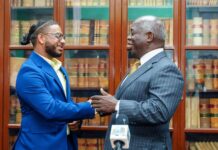
LETTERS TO THE EDITOR
The Re-emergence of the UBP
Dear Editor,
There should be growing concern among original members of the Free National Movement (FNM) that the FNM that exists today in no way resembles the political movement that was established at Jimmy Shepherd’s house on Spring Hills Farms in Fox Hill in 1971.
In fact, under Prime Minister Hubert Ingraham, the current FNM is a reincarnation of the United Bahamian Party (UBP), although it’s not as openly racist and oppressive against blacks as the predominantly white UBP was before the Progressive Liberal Party (PLP) defeated them at the polls in the historic January 10, 1967, general election.
And it may very well be that this was the “master plan” of the UBP after they disbanded in 1971 and joined forces with a dissident group of parliamentarians who broke away from the PLP in 1970. Historically referred to as The Dissident Eight, this group included Cecil Wallace Whitfield, Arthur Foulkes, Warren Levarity, Maurice Moore, Dr. Curtis McMillan, James Shepherd, Dr. Elwood Donaldson and George Thompson.
Here’s a hypothesis worthy of consideration. In disbanding the UBP, members of the party realized that the political tide had changed against them forever and there was no imaginable way they could ever again become the government of The Bahamas under the banner of the UBP. Therefore, those who felt that they still had a political contribution to make to the country decided that their best chance of positioning themselves to again be involved in a meaningful way in the political process was to team up with the Dissident Eight.
Following meetings held at Spring Hill Farms, the FNM officially became a political party in October of 1971, with Cecil Wallace-Whitfield, a charismatic and skillful political operative, as its leader. Clearly, with Wallace-Whitfield at the helm of the party, the former UBP members of the FNM quickly deduced that they did not have a snowball’s chance in hell of influencing the direction of the party, so they remained in the background primarily making meaningful contributions financially.
Wallace-Whitfield had a domineering personality and this led to a serious rift within the FNM, resulting in some leading members of the party establishing the Bahamas Democratic Party (BDP), under the leadership of Sir Kendal Isaacs, while the FNM remained under Wallace-Whitfield’s leadership. Quite possibly this may have been the first attempt by the UBP faction within the FNM to again have more influence in Bahamian politics, but both the FNM and the BDP were convincingly defeated by the PLP in the 1977 general election.
Realizing that they had made a drastic mistake by dividing the opposition forces, the FNM and the BDP reunited under the banner of the FNM, with Isaacs still as opposition leader heading into the 1982 general election. Once again they were soundly defeated by the PLP.
Five years later, with Isaacs still as its leader, the FNM was again defeated by PLP in the 1987 general election, after which Isaacs resigned and Wallace-Whitfield once again took over the helm of the party’s leadership.
Then in 1990, with Wallace-Whitfield battling lung cancer, Ingraham, who had been expelled from the PLP in 1984, joined the FNM. When Wallace-Whitfield died in May of 1990, Ingraham was elected FNM leader, amidst unsubstantiated reports that he was hand-picked by Wallace-Whitfield to replace him. He led the FNM to a landslide victory in the August 1992 general election, winning 32 of the then 49 seats in the House of Assembly.
There’s no disputing the fact that Ingraham’s first five-year term as Prime Minister was an unqualified success, but from the onset of his tenure as the country’s political leader there were reports of concern about his dictatorial tendencies among some of his colleagues. However, based on his promise that he only intended to serve two terms as Prime Minister, they considered this to be an ego issue and not an indication that he had plans of becoming The Bahamas’ equivalent of Haiti’s notorious despot, Francois “Papa Doc” Duvalier.
After leading the FNM again to victory in 1997, Ingraham embarked on his second five-year term still promising to only serve two terms as Prime Minister, and he certainly indicated that he intended to keep that promise when he orchestrated a special election within the FNM in 2001 to select a leader-designate and a deputy leader-designate, throwing his full support during the campaign behind Tommy Turnquest as leader-designate and Dion Foulkes as deputy leader-designate.
But after the PLP’s stunning victory at the polls in 2002, Ingraham went back on his word to serve only two terms and encouraged his supporters within the FNM to mount a campaign to encourage him to return as FNM leader, although he had given a firm promise to Turnquest that he would not seek the leadership position. Of course, he was restored as leader of the FNM, and it was probably at this time that he really realized that he could do whatever he wanted to do within the party without worrying about the political consequences.
It was probably also around this time that the UBP faction within the FNM decided that this was their best opportunity in years to re-emerge as an influential arm of the party. They had in Ingraham the right man to carry the ball for them, knowing that there was evidence to suggest that he suffers from a serious inferiority complex and adores white people.
Probably the most egregious example of the tremendous influence that the UBP has within the FNM under Ingraham is the fact that Brent Symonette is the country’s deputy prime minister. Consider this for a moment: If Ingraham’s support for Tommy Turnquest in the party’s special election to determine who would replace him as leader was indeed genuine, shouldn’t Turnquest have been made Deputy Prime Minister when the FNM returned to power in 2007? Keep in mind that Brent Symonette is the son of the late Sir Roland Symonette, the leader of the UBP when it was defeated by the PLP in the 1967 general election. And this is the same Brent Symonette who is alleged to have some interest in a concrete company that gets most of the big government road building contracts.
This latter fact is in keeping the tremendous influence former UBP members now wield in determining the policies of the FNM under Hubert Ingraham. Surely, a review of the various pieces of legislation passed by the FNM Government involving government spending during Ingraham’s current term as Prime Minister will show that they were overwhelmingly designed to further enrich former UBP members at the expense of poor and working-class Bahamians.
What’s more, one of Ingraham’s closest confidants is Lynn Holowesko, President of the Senate. Don’t let the last name fool you. She is a member of a dyed-in-the wool UBP family; her maiden name is Pyfrom.
Meanwhile, Ingraham has skillfully made every effort to erase the leadership legacy of Cecil Wallace-Whitfield. Surely, die-hard FNM supporters in Grand Bahama would have taken note of the fact that Ingraham has failed to show up in recent years for events planned in Grand Bahama to celebrate Wallace-Whitfield’s birthday. That’s clearly because Ingraham now views the FNM as being his party, and with the support of the former UBPs he is now working on establishing his own legacy.
Obviously, it’s impossible for former UBPs to turn back the clock to that disgraceful period in Bahamian history when, as late as the early 1960s, black Bahamians could not go to the all-white Savoy Theatre on Bay Street and the only blacks working in banks were as janitors. But as long as Hubert Ingraham’s policies make it easy for them to become richer and richer, politically they are back in power.
That’s one aspect of Hubert Ingraham’s legacy that should be filed under the heading “DISGRACEFUL.”
Yours sincerely,
Oswald T. Brown
Freeport, Grand Bahama
May 10, 2011







